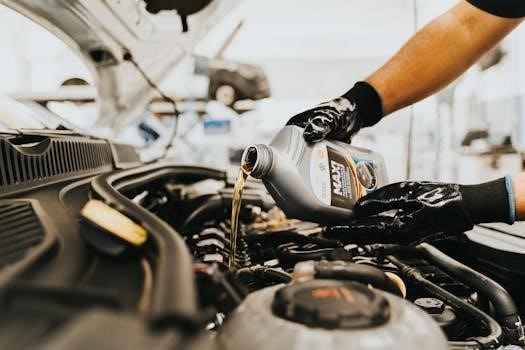Lubrication failure is a significant concern in machinery maintenance, often leading to premature wear and catastrophic damage. It stems from various issues, including improper lubricant selection and application, contamination, and degradation over time.
Importance of Proper Lubrication
Proper lubrication is crucial for the longevity and efficient operation of machinery. It minimizes friction between moving parts, reducing wear and preventing overheating. Adequate lubrication also helps dissipate heat, preventing thermal damage and maintaining stable operating temperatures. Furthermore, it acts as a barrier against contaminants, protecting critical components from corrosion and abrasive wear. Effective lubrication extends the lifespan of equipment, reduces downtime due to failures, and lowers maintenance costs. Ignoring proper lubrication practices can lead to costly repairs, production interruptions, and even safety hazards. Therefore, a well-implemented lubrication program is an essential investment for any operation that relies on mechanical equipment. By following best practices in selection and application, organizations can avoid significant losses.

Major Causes of Lubrication Failure
Several factors contribute to lubrication failure, including temperature extremes, foreign particle contamination, moisture ingress, and changes in lubricant viscosity, all of which compromise effectiveness.
Temperature as a Failure Mode
Elevated temperatures significantly impact lubricant performance and longevity. High temperatures accelerate the oxidation process of lubricants, leading to a breakdown of their chemical structure and a reduction in their lubricating properties. This can result in a loss of viscosity, making the lubricant less effective at preventing metal-to-metal contact. Furthermore, excessive heat can cause thermal degradation, leading to the formation of sludge and varnish, which can clog lubrication systems and further exacerbate wear. Overfilling lubricant reservoirs can also contribute to temperature-related failures due to increased friction and heat generation. Maintaining proper operating temperatures is therefore critical to prevent premature lubricant failure and equipment damage.
Contamination by Foreign Particles
Foreign particle contamination is a leading cause of lubrication failure, introducing abrasive elements into the system. These particles, including dirt, dust, metal shavings, and grit, can disrupt the lubricating film, causing increased friction and wear between moving parts. The abrasive nature of these contaminants leads to accelerated wear on critical components such as bearings and gears. Contamination can also initiate a chain reaction, where wear particles become new contaminants, further amplifying the problem. Moreover, contaminated lubricants lose their effectiveness, diminishing their ability to protect machine parts. Proper filtration and sealing are essential to prevent particle ingress and maintain lubricant purity, significantly reducing the risk of premature wear and system failure.
Moisture Ingress and its Effects
Moisture ingress into lubrication systems poses a significant threat, triggering a cascade of detrimental effects. Water contamination leads to lubricant degradation, often resulting in the formation of corrosive byproducts such as hydrogen sulfide and sulfuric acid. These acids accelerate wear and corrosion on metal surfaces. Additionally, water reduces the lubricant’s viscosity and film strength, compromising its ability to provide adequate protection. The presence of water can also promote the growth of microbial contaminants, further degrading the lubricant and causing sludge formation. This sludge can clog filters and oil passages, leading to oil starvation and component failure. Proper seals and dehumidification measures are crucial to prevent moisture ingress and protect machinery.
Viscosity Changes in Lubricants
Viscosity, a crucial property of lubricants, significantly impacts their performance. Changes in viscosity, whether an increase or decrease, can lead to lubrication failure. High temperatures can cause a lubricant’s viscosity to decrease, resulting in a thinner film that may not adequately separate moving parts, leading to increased friction and wear. Conversely, low temperatures can increase viscosity, making the lubricant too thick to flow properly, causing oil starvation and inadequate lubrication. Contamination and oxidation can also alter a lubricant’s viscosity, diminishing its effectiveness. It is therefore essential to select a lubricant with the appropriate viscosity for the operating conditions and to monitor its condition through regular oil analysis to detect any detrimental changes.

Consequences of Lubrication Failure
Lubrication failure leads to severe outcomes, including bearing damage, increased friction, and catastrophic machinery breakdowns. These failures cause costly repairs, downtime, and reduced operational efficiency within industrial settings.
Bearing Failure and Premature Wear
Bearing failure and premature wear are direct and significant consequences of inadequate lubrication. When lubrication is insufficient, the metallic surfaces of bearings experience increased friction, leading to excessive heat generation and material degradation. This friction not only accelerates wear but also causes surface pitting, spalling, and eventual bearing seizure. Inadequate lubrication prevents proper film formation, which is essential for separating moving parts, causing direct contact and subsequent damage. Furthermore, improper lubrication practices, such as using the wrong type of lubricant or over-greasing, can also contribute to premature bearing failure. The resulting downtime and repair costs can significantly impact operational efficiency and profitability. Therefore, maintaining proper lubrication is crucial for preventing these failures.
Catastrophic Damage to Machinery
Catastrophic damage to machinery represents the most severe outcome of lubrication failure. When lubrication fails, the resulting friction and heat can lead to rapid and irreversible damage of critical components. This can manifest as complete seizure of moving parts, fractured shafts, and shattered gears. The escalating damage can propagate throughout the machinery, rendering it inoperable and often requiring extensive and costly repairs or complete replacement. Furthermore, the sudden and unexpected nature of catastrophic failures can pose safety risks to personnel and cause significant disruptions to production schedules. The financial repercussions extend beyond repair costs to include lost productivity, potential penalties, and decreased overall efficiency. Therefore, preventing lubrication failure is essential to safeguard machinery and prevent such debilitating events.

Preventive Measures and Best Practices
Preventive measures include proper lubricant selection, correct application techniques, and regular oil analysis. These practices help maintain optimal lubrication, thus minimizing the risk of equipment failure and ensuring longevity.
Proper Lubricant Selection

Choosing the correct lubricant is paramount for preventing lubrication failures. This involves considering the specific machinery’s requirements, operating conditions, and environmental factors. Selecting a lubricant with the appropriate viscosity is crucial to maintain a sufficient film between moving parts, preventing wear and reducing friction. The lubricant must also be compatible with the materials used in the machinery. Furthermore, it should possess properties that withstand the operating temperature and pressure ranges. An inappropriate lubricant can cause premature degradation, leading to reduced protection and increased risk of failure. Therefore, careful evaluation and adherence to manufacturer guidelines are essential for optimal machinery performance and longevity. Improper lubricant selection is one of the main causes of lubrication failure and it must be addressed to prevent damage.
Correct Application Techniques
Applying lubricants correctly is just as vital as selecting the right lubricant. Over-lubrication, despite good intentions, can be detrimental, leading to increased temperatures and potential failures. Using the right amount of lubricant, as specified by the manufacturer, ensures optimal performance. Proper application methods, whether manual or automatic, guarantee even distribution, preventing dry spots and reducing wear. Additionally, the use of specialized tools for lubrication can minimize contamination and ensure that the lubricant reaches the critical areas. Correct application techniques also involve scheduling lubrication tasks at appropriate intervals, preventing both under-lubrication and over-lubrication. In conclusion, attention to detail during the application phase is critical for maximizing the effectiveness of the lubricant and preventing premature machinery failure. This is a vital step in preventing lubrication failure.
Regular Oil Analysis and Monitoring
Regular oil analysis and monitoring are essential for preventing lubrication failure. These practices provide valuable insights into the condition of both the lubricant and the machinery. Oil analysis can detect contaminants, such as water and foreign particles, which can lead to premature wear and damage. Furthermore, monitoring the viscosity, acidity, and other key properties of the lubricant can indicate degradation and the need for replacement. This proactive approach allows for timely intervention, preventing minor issues from escalating into major failures. By identifying problems early, regular oil analysis and monitoring not only extend the lifespan of equipment but also reduce the risk of costly downtime and repairs. Implementing a consistent monitoring program is a vital part of a comprehensive lubrication management strategy. This helps to ensure optimal machinery performance and reliability.